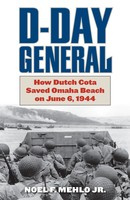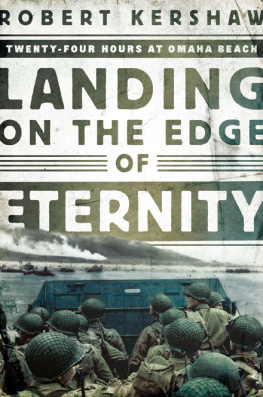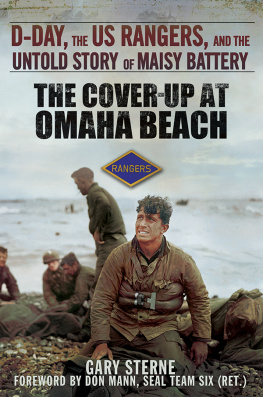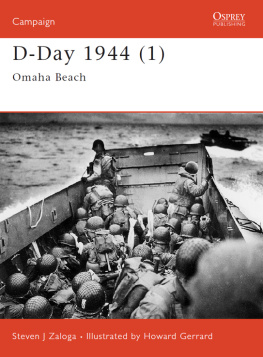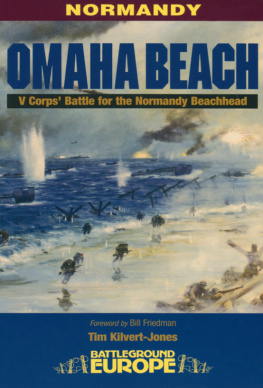Copyright 2004 by Stackpole Books
Published by
STACKPOLE BOOKS
5067 Ritter Road
Mechanicsburg, PA 17055
www.stackpolebooks.com
All rights reserved, including the right to reproduce this book or portions thereof in any form or by any means, electronic or mechanical, including photocopying, recording, or by any information storage and retrieval system, without permission in writing from the publisher. All inquiries should be addressed to Stackpole Books, 5067 Ritter Road, Mechanicsburg, Pennsylvania 17055.
Printed in the United States of America
10 9 8 7 6 5 4 3 2
Paperback edition 2006
ISBN 0-8117-3376-9 (paperback)
ISBN 978-0-8117-3376-2
The Library of Congress has cataloged the hardcover edition as follows:
Balkoski, Joseph.
Omaha Beach: D-Day, June 6, 1944 / by Joseph Balkoski. 1st ed.
p. cm.
Includes bibliographical references and index.
ISBN 0-8117-0079-8
1. Operation Neptune. I. Title.
D756.5.N6 B343 2004
940.54'21422dc22
ISBN 978-0-8117-0079-5
2003021928
eISBN 9780811741194
This book is dedicated to
the American and British servicemen,
living and dead,
who participated in the
Omaha Beach invasion,
June 6, 1944
Unita Fortior
In Unity There is Strength
Contents
| ix |
| Chapter 1. | |
| Chapter 2. | |
| Chapter 3. | |
| Chapter 4. | |
| Chapter 5. | |
| Chapter 6. | |
| Chapter 7. | |
| Chapter 8. | |
| Chapter 9. | |
| Chapter 10. | |
| Chapter 11. | |
| Chapter 12. | |
| Chapter 13. | |
| Chapter 14. | |
| Appendix I: | |
| Appendix II: | |
| Appendix III: | |
| Appendix IV: | |
| Appendix V: | |
|
|
|
|
Maps
| The Strategic Options, 1944 | |
| June 6, 1944: Omaha Beach | |
| June 5, 1944: Force O Movement to Normandy | |
| Force O: Transports and Naval Bombardment | |
| Eighth Air Force: 2nd Bomb Division on D-Day | |
| H-Hour: 741st and 743rd Tank Battalions | |
| H-Hour: Vierville Draw | |
| H-Hour: Les Moulins Draw | |
| H-Hour: Cabourg Draw | |
| H-Hour: Colleville Draw | |
| H-Hour: Actions of U.S. Demolition Teams | |
| 7:15 A.M.: Hamel au Prtre and the Vierville Draw | |
| 7:00 A.M.: Colleville Draw | |
| 7:308:30 A.M.: LCI First Tide Landings | |
| 7:40 A.M.: St. Laurent Draw | |
| 7:30 A.M.: Brig. Gen. Norman Cota Lands | |
| 8:15 A.M.: Spalding and Dawson Move Inland | |
| 9:00 A.M.: The Eastern Flank Secured | |
| 9:00 A.M.: C Company, 2nd Rangers, Moves Inland | |
| 8:30 A.M.: Rangers and Stonewallers Move Up the Bluff | |
| 8:30 A.M.: 3rd Battalion, 116th Infantry, Moves Inland | |
| 10:00 A.M.: St. Laurent Draw | |
| 10:00 A.M.1:00 P.M.: Vierville-sur-Mer | |
| 10:00 A.M.7:00 P.M.: Colleville-sur-Mer | |
| 10:00 A.M.4:00 P.M.: Cabourg | |
| Noon9:00 P.M.: St. Laurent | |
| Omaha Beach at End of the Day, June 6, 1944 | |
Preface
They couldnt stop thinking about the ships. There were just so many of them. To those who witnessed it, anything that had transpired in their lives beforehand seemed trivial in comparison. Here was something worthy of telling your grandchildrenbut if events shaped up as the top brass expected, a lot of good men aboard those ships would not be alive by sunset, and virtually every soldier and sailor involved in the operation surely wondered whether or not he would be one of those.
The ships had secret appointments in the predawn darkness of June 6, 1944, off the coast of Normandy. Their anchor chains would soon slip thunderously into the sea a few miles off beaches code-named Omaha, Utah, Sword, Juno, and Gold, and one of the most momentous struggles in world history would begin. The conferences, the plans, the exercises were meaningless now: soon, real bullets would fly and men would be killed; and the destiny of millions would hinge on the success or failure of the invasion the world would come to know simply as D-Day.
It is axiomatic that no military operation ever unfolds according to plan, and D-Day was no exception. Compared to other amphibious operations that had come before it in World War II, however, the Normandy invasion was, for the most part, remarkably successful, thanks in large measure to the Allies colossal concentration of force and meticulous preparation for an assault they deemed to be the wars most significant military undertaking.
Shortly after dawn, British and Canadian troops stormed ashore on Sword, Juno, and Gold Beaches, breaking through the enemys coastal defenses quickly, despite the four years of preparation the Germans had had to prepare for the inevitable Allied invasion. Meanwhile, on and beyond Utah Beach in the eastern Cotentin Peninsula, American infantrymen, paratroopers, and glider troops methodically reduced German defenses in a coordinated airborne-amphibious assault that early invasion planners had once considered much too risky to include as part of Operation Overlord.
When the first sketchy intelligence reports of the fighting in Normandy reached Gen. Dwight Eisenhowers SHAEF headquarters on the morning of June 6, Ike and his staff officers breathed a sigh of relief: after all the doubts and uncertainty, the invasion was clearly succeeding. But not all news from the front was positive. On a beach code-named Omaha, the critical connector between the American forces in the Cotentin, and British-Canadian forces to the east, the invasion had started calamitously. Rumors of terrible casualties among the first waves, paralysis on the beach, and unyielding enemy defenses were filtering into SHAEF headquarters all morning. The only course of action was to wait out the crisis and hope that the fighting men on the beach would have the know-how to sort out the chaos on their own initiative, and bring the invasion timetable back on track.
That the GIs on Omaha Beach did indeed possess the essential fighting skills to save the day has become an elemental moral of American history. No one realized it at the time, particularly the unfortunate men who were subjected to the enemys relentless barrage of bullets and shells, but Omaha Beach would become one of those exceptional moments in history when Americans defined themselves by their actions as a people worthy of the principles upon which the nation was founded. Yet it is particularly ironic that sixty years after D-Day, Americans still do not know all the details about that momentous day in June 1944 when their soldiers stormed ashore in France to begin the liberation of Europe.



